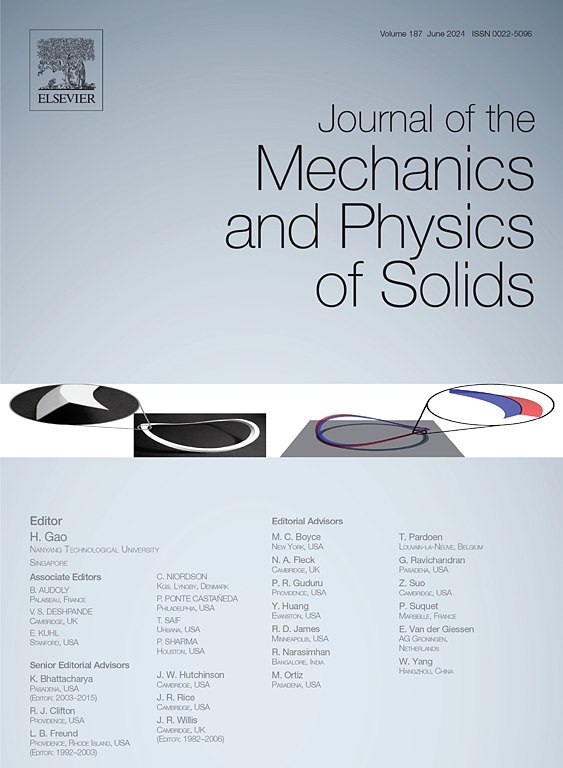Biomimetic Turing machine: A multiscale theoretical framework for the inverse design of target space curves
IF 5
2区 工程技术
Q2 MATERIALS SCIENCE, MULTIDISCIPLINARY
引用次数: 0
Abstract
Morphing ribbons and their inverse design are usually confined to plane curves, since in most cases only the curvature is considered. Given that curvature and torsion are equally important geometric characteristics of space curves, it is urgent to propose a systematic theoretical framework for the inverse design. Toward this end, we here present a multiscale theoretical framework named biomimetic Turing machine (BTM) to achieve desired target space curves, which is inspired from two microstructural regulation mechanisms behind the hydration-driven morphing of plant tissues: the graded curvature regulated by matrix volume fraction (cm) and the helix-like morphology regulated by fibril orientation angle (FOA). By analogizing to Turing machine encoded by binary mapping, the proposed BTM can inversely encode a morphing ribbon with preset microstructural parameters (FOA and cm) to achieve desired target space curves. The proposed theoretical framework can first bridge the microstructural fiber-matrix swelling and the macroscopic ribbon morphing as a forward problem, in which a twist field is subsequently introduced to create the kinematic map between the target space curve and the ribbon, innovatively posing the inverse design as an initial value problem. To facilitate the experimental implementation of BTM, we further propose an optimization strategy for selecting the twist field and provide design criteria as guidelines for experiments. As a conceptual display, we present a phase diagram in the cm versus FOA plane to illustrate the complex target morphologies (e.g., hemisphere, hyperboloid, and tendril) characterized by various parameters of curvature and torsion designed rationally by the BTM theory, while in previous studies the morphing morphologies (e.g., helices, arcs, and helicoid ribbons) exhibit only constant curvature or torsion. This work presents a novel inverse design strategy for space curves with both curvature and torsion, broadening the potential for the design and fabrication of morphing materials.
仿生图灵机:目标空间曲线反设计的多尺度理论框架
变形带及其逆设计通常局限于平面曲线,因为在大多数情况下只考虑曲率。鉴于曲率和扭转是空间曲线同样重要的几何特征,迫切需要提出一个系统的反设计理论框架。为此,我们提出了仿生图灵机(BTM)的多尺度理论框架,以实现所需的目标空间曲线,该框架的灵感来自于植物组织水化变形背后的两种微观结构调节机制:由基质体积分数(cm)调节的渐变曲率和由纤维取向角(FOA)调节的螺旋状形态。该算法通过类比采用二值映射编码的图灵机,对具有预设微结构参数(FOA和cm)的变形带进行反向编码,从而获得期望的目标空间曲线。所提出的理论框架首先将微观结构纤维基质膨胀和宏观带状变形作为正演问题连接起来,随后引入扭转场来创建目标空间曲线与带状之间的运动学映射,创新地将反设计作为初值问题。为了方便BTM的实验实现,我们进一步提出了一种优化选择扭转场的策略,并提供了设计准则作为实验指导。作为一种概念性展示,我们在cm平面和FOA平面上绘制了相位图,以说明由BTM理论合理设计的各种曲率和扭转参数表征的复杂目标形态(如半球、双曲面和卷须),而在以往的研究中,变形形态(如螺旋、圆弧和螺旋带)只有恒定的曲率或扭转。本研究提出了一种具有曲率和扭转的空间曲线的新型逆设计策略,为变形材料的设计和制造拓展了潜力。
本文章由计算机程序翻译,如有差异,请以英文原文为准。
求助全文
约1分钟内获得全文
求助全文
来源期刊
CiteScore
9.80
自引率
9.40%
发文量
276
审稿时长
52 days
期刊介绍:
The aim of Journal of The Mechanics and Physics of Solids is to publish research of the highest quality and of lasting significance on the mechanics of solids. The scope is broad, from fundamental concepts in mechanics to the analysis of novel phenomena and applications. Solids are interpreted broadly to include both hard and soft materials as well as natural and synthetic structures. The approach can be theoretical, experimental or computational.This research activity sits within engineering science and the allied areas of applied mathematics, materials science, bio-mechanics, applied physics, and geophysics.
The Journal was founded in 1952 by Rodney Hill, who was its Editor-in-Chief until 1968. The topics of interest to the Journal evolve with developments in the subject but its basic ethos remains the same: to publish research of the highest quality relating to the mechanics of solids. Thus, emphasis is placed on the development of fundamental concepts of mechanics and novel applications of these concepts based on theoretical, experimental or computational approaches, drawing upon the various branches of engineering science and the allied areas within applied mathematics, materials science, structural engineering, applied physics, and geophysics.
The main purpose of the Journal is to foster scientific understanding of the processes of deformation and mechanical failure of all solid materials, both technological and natural, and the connections between these processes and their underlying physical mechanisms. In this sense, the content of the Journal should reflect the current state of the discipline in analysis, experimental observation, and numerical simulation. In the interest of achieving this goal, authors are encouraged to consider the significance of their contributions for the field of mechanics and the implications of their results, in addition to describing the details of their work.

 求助内容:
求助内容: 应助结果提醒方式:
应助结果提醒方式:


